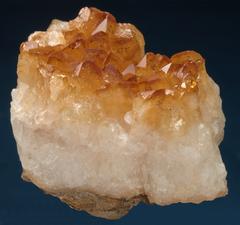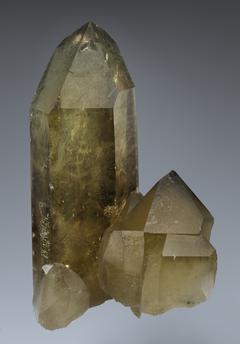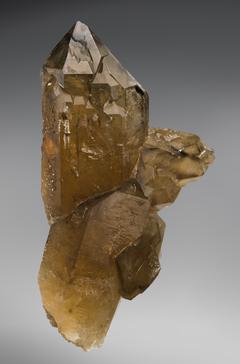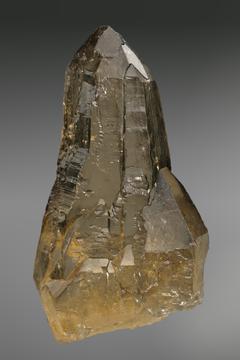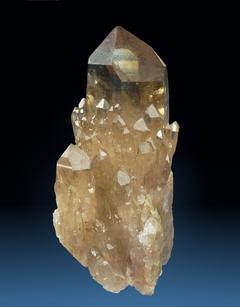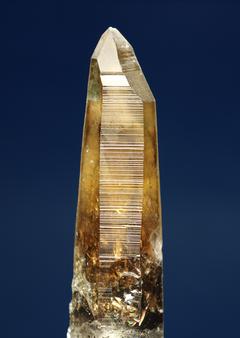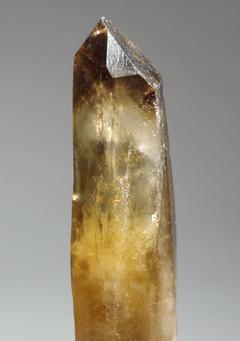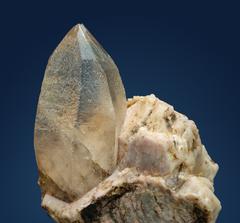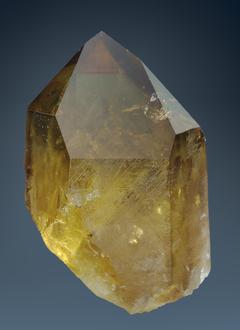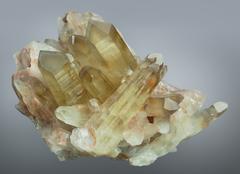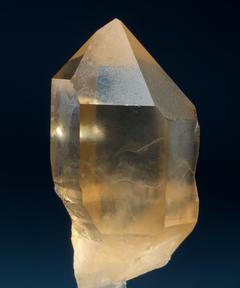Citrine
Specific Properties
Occurrence
Locations and Specimen
Further Information
Specific Properties
Occurrence
Locations and Specimen
Further Information
Document status: complete
Citrine is a transparent, yellow macrocrystalline quartz variety. Natural citrine is very rare, in fact almost all the material offered on the market under that name is not natural citrine, but heat treated amethyst.
The two pictures to the right show a citrine crystal from Hasawarka, Russia. When illuminated directly from the front, the crystal appears very dark and almost green. But when the crystal is illuminated from behind, its real color is revealed: a deep and homogeneously distributed yellow.
In jewelery, faceted citrine used to be sold as "gold topaz". I don't know if that is still common practice, but as far as I know the traders codex does not allow this anymore.
On this web site, I do not call quartz citrine if it is yellow because of inclusions of iron oxide minerals, but ferruginous quartz or "eisenkiesel". Thus I use a different definition: Citrine is a transparent yellow quartz variety whose color is caused by colorizing agents that are built into the crystal lattice and whose color is not caused by inclusions of other minerals. I do this for reasons of consistency in the naming, but by gemologists' standards it is o.k. to call a quartz with finely distributed iron minerals, including heat-treated amethysts, a "citrine".
If you checked different sources in books and in the Internet, the explanation for the yellow color that is almost exclusively given is: traces of iron. However, there seem to be at least 2 kinds of citrine that differ in the cause of the color and possibly in their inner structure (see "Specific Properties").
Specific Properties
Going through the literature to learn about the causes of the greenish-yellow, yellow or orange color is leaving an impression that there are at least 2 different yellow quartz varieties, and at least 3 if you count heat treated amethyst.
Whatever the cause of the color and however much people differ on what qualifies as "citrine", the common denominator seems to be that the colorizing agent should be more or less evenly and finely distributed in the crystals and that the crystals should appear transparent. Nobody calls a yellow but opaque crystal or a clear crystal with yellow grainy or fibrous inclusions a citrine.
Note: the following names "aluminum citrine" and "iron citrine" are not officially approved, I just made them up as a convenient label.
"Aluminum Citrine"
Like the color of smoky quartz, the color of this type of citrine is caused by irradiation and traces of aluminum built into its crystal framework. The yellow can be very deep with shades of green, but usually is a little pale. This citrine shows a very weak dichroism, that is, its color changes a bit depending on the angle of the incoming light (see Physical Properties for an explanation).
This citrine will actually loose its color upon heating to more than 200°C, and the yellow color will occur again when the crystal is irradiated with x- or gamma-rays. This is not the case for heat treated amethyst (see below), which turns yellow at - very high - temperatures that will turn natural citrine white.
Some smoky quartz from certain locations (e.g. Peterson Mountain, Nevada) shows a yellow tone in parts of its crystals. Some yellowish smoky quartz can even be turned into citrine by careful heating, because the color centers in citrine are more stable and the smoky color disappears before the yellow. "Aluminum citrine" is usually evenly colored, though "phantoms" of smoky quartz are found occasionally. It is probably impossible to distinguish heat treated smoky quartz from true citrine, as it is impossible to identify an artificially irradiated citrine. You have to check reports about the location to be sure.
Why citrine turns out yellow and not smoky despite the fact that the same trace elements are built in is still a matter of debate. In studies on Brazilian quartz crystals that were artificially irradiated to determine high-purity specimen for industrial use, Jung, 1992, found that the ratio of the amount of aluminum and the amount of lithium built into the crystal lattice is possibly a critical factor. Crystals with a Li:Al ratio of close to 1 will assume the typical smoky quartz or black (morion) color upon irradiation, whereas crystals with a Li:Al ratio of about 0.5 will assume a honey color and those with a Li:Al ratio of less than 0.3 will turn yellow. The depth of the color varies with the absolute amount of Li and Al, and the yellow may be faint or very dark.
This type of citrine can basically appear in the same crystal habits and crystal forms as rock crystal or smoky quartz, but good crystals are said to be rare. It can show accessorial crystal faces, like the dipyramidal s- or the trapezoidal x-face, just like rock crystal and smoky quartz. A citrine showing these faces is most likely not a heat treated amethyst.
"Iron Citrine"
Quartz crystals artificially grown from a hot watery silica solution (hydrothermal synthesis) turn out yellow if iron compounds are added to the solution. The iron seems to be incorporated into the crystal lattice. Although these quartzes sometimes lack the polysynthetical twinning that is common in natural amethyst, they are converted into amethysts by irradiation.
It is likely that at least some of the natural citrines fall into the same category.
"Heated Amethyst"
It used to be quite common to produce "citrine" by heating amethyst. For this the amethyst does not need to have a deep color, faint or almost gray specimen may also assume a deep yellow or orange color upon heating. Once offered in great amounts, crystallized mineral specimen treated in such a way have actually almost disappeared from fairs, as collectors apparently don't want to pay that much for something that has been artificially altered. Heat treated amethyst is sold by the lot as "citrine" for lapidary purposes.
As the distribution of color of amethyst is very different from that of most natural citrine, a heat treated amethyst is easily recognized: the yellow color is most intense in the tips, and the color might be more concentrated under the r-rhombohedra or patchy. Yellow or orange quartz in druzy geodes is most likely - and I would tend to say always - heated amethyst. Goethite inclusions are very suspicious, of course. On the other hand, citrine crystals showing accessorial faces can hardly be heat treated amethyst. If the crystal is clear, you can check for dichroism: natural citrine is often slightly dichroic, whereas heated amethyst is not (see Physical Properties for a method to check this).
Note: according to the lapidary traders codex it is o.k. to call heat treated amethyst citrine.
Occurrence
Citrine occurs in the same environments as smoky quartz, mostly intrusive igneous rocks which contain traces of radioactive elements whose radiation cause the coloration.
Locations and Specimen
Citrine is a rare quartz variety. It is found in good quality in Brazil, Madagascar, and Russia. Recently artichoke like crystals from Kongo have shown up on fairs. Very few locations in the Alps (all in Austria) have yielded citrine, the already rare alpine amethyst is much more common.
There are also a couple of locations of smoky quartz with shades of yellow, Peterson Mountain a.k.a. Hallelujah Junction has already been mentioned.
Brazil
This citrine comes from Minas Gerais, Brazil. The friendly trader told me it would actually be a "Brasilit" (German spelling), and very likely had been subject to some treatment. "Brazilite" is a synonym of baddeleyite, ZrO2, and "brasilianite" is NaAl3[(OH)2|PO4]2.
I couldn't find out anything more about "Brasilit" than it might possibly be a name for honey colored citrine. This specimen is not honey colored like what I saw on the few pictures on the Internet, but more lime colored. The honey colored material looked a bit like heated amethyst to me. The specimen shown here is almost certainly not a heated amethyst, because there is a small s-face on one of the crystals. So the only possibilities I could think of would be a moderately heated smoky quartz or an irradiated rock crystal. I've shown the specimen to an mineralogist and to an expert for jewelery, but both hadn't heard of an actual use of such treatments, and of course, there are no hints within the crystal itself that point to anything like moderate heating or irradiation. You can't tell just by looking at it, as you can with heat treated amethyst.
Meanwhile I'm pretty sure it's a natural citrine.
A slightly smoky citrine with very even color from Corinto, Minas Gerais. The surface structure on the prism faces indicates Brazil law domains, very similar to the ones on the specimen from Russia.
Since their color centers are related, smoky quartz and citrine may show all kinds of transitions. A lot of citrine from Minas Gerais is of more or less smoky yellow or orange color. This specimen has an evenly colored yellow-orange core, but the outer layers with the skeletal quartz surface patterns show smoky color along some of the edges. Crystals like the one shown are found in pegmatite pockets around the cities of Araçuaí and Itinga, Jequitinhonha valley, Minas Gerais.
This is crystal would be considered a smoky quartz by many people, its color is of a light yellow-brown. It shows an interesting combination of macromosaic sutures and beginning skeleton quartz growth patterns. From a pegmatite near Itinga, Jequitinhonha valley, Minas Gerais.
Congo
Citrines with a typical artichoke quartz habit have recently appeared on the market, first very few of them, but batches of large crystals since 2006. They are found in weathered rock at small scale mining operations at Lueni, Katanga province.
Most crystals are at least a bit smoky in color. One can frequently see faint smoky phantoms. Their most characteristic feature is the candle quartz habit (some would call it artichoke quartz habit) that apparently can be found in all specimen from that location. A more smoky specimen is shown at the growth form section. Citrine of similar habit is said to come from the Andes mountains.
Kazakhstan
This crystal from Akjaylan in eastern Kazakhstan shows several smoky layers parallel to the large rhombohedral face. It has been found in a pegmatite and there is still some mica attached at the crystal's base. It is also a very nice demonstration of what the stripes on the prism come from: it's just a pattern of alternating rhombohedra and prisms, the last stair step being visible at the crystal tip.
Madagascar
This crystal from Anjoma, Madagascar, shows a citrine phantom underneath a clear smoky tip and serves as another example of a combined citrine/smoky quartz. The yellow color is most intense at the base of the crystal.
Namibia
A clear and very pale citrine crystal on microcline feldspar from a miarole pocket in granite at the western Erongo mountains. The crystal would qualify as a stubby Tessin or transitional habit crystal. Its surface is etched, as many crystals from pegmatite and miarole pockets.
Russia
The specimen to the right is the same jewelery grade citrine shown on the pictures on top of the page (found at Hasawarka in the Ural mountains) from a different perspective, and partially illuminated from the back so one can see its dark yellow color. It looks very different from the burnt amethyst you usually get, with a dark homogeneous color and nicely developed prisms. The prism shows an interesting pattern of lines parallel to the planes of the rhombohedra, leading to a mosaic of triangles. This pattern is very likely due to a Brazil law twinning of the crystal that has been revealed by natural etching.
Matrix specimen of citrine are difficult to get. This one is from Perekatnoye near Aldan, Yakutia. There are brown phantoms of smoky quartz color zones under the rhombohedral faces at the crystal tips. The brown-red patches on the matrix are caused by iron compounds.
U.S.A.
A pale citrine-colored scepter from Peterson Mountain, California/Nevada. This crystal is slightly dichroic (I thought it is not, but I checked again and it is). It appears to be not perfectly clear, but the latter is in part due to the fact that the crystal's surface has been etched naturally. The crystal has spent several days in HCl and has been brushed thoroughly, so the color is not caused by a superficial stain of limonite.
Judging from the tone of the color and my erroneous belief that the crystal is not dichroic, my first guess was that the color is caused by iron, either embedded in compounds or built into the crystal lattice. And since this crystal has been found in a small pocket in the same granite that produces smoky quartz, and thus has been subject to prolonged high energy radiation, I wondered why it is not purple like the many other amethyst found at that locality and speculated that this is a ferruginous quartz. After I have checked the crystal again and found that the crystal is dichroic, I would say that this is probably a true citrine.
Further Information, Literature, Links
Footnotes

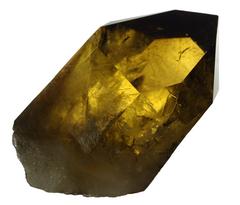
![]()

